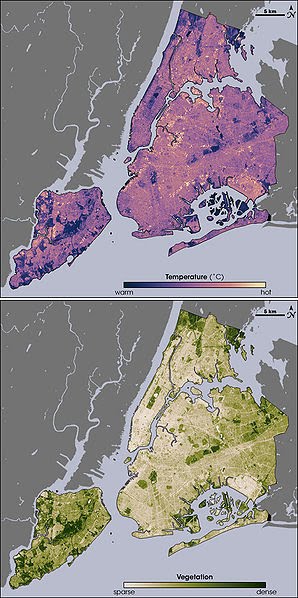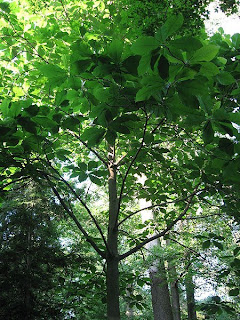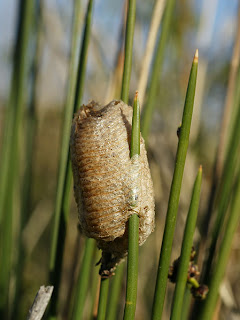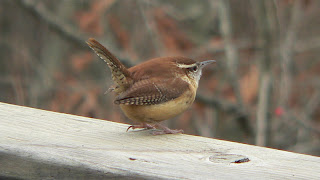One green concept that has fascinated me for quite a while is the green roof. I am astounded that you don’t hear more about them! A green roof is exactly what it sounds like; it’s a roof that is planted with vegetation. Please see the photo to the right of a French museum, taken by Simon Garbutt. They’ve actually been around for centuries in Northern Scandanavia and Europe. Checkout the photo of a traditional farm village in Norway, bottom. Did you know, it's estimated that 10% of Germany's roofs are 'green'?
One of the key benefits of a green roof is temperature reduction of roofing material. As you may know, the majority of buildings in urban areas are roofed with black asphalt and homes are roofed with dark asphalt shingles- they get hot! This combined with asphalt roads and few trees produces a pocket of hot air that surrounds the city, called the Urban Heat Island Effect. This area of hot air has even been known to change weather patterns!
 How do green roofs reduce Urban Heat Island Effect, you ask? Well, imagine you’re walking barefooted on a July afternoon in Atlanta. You leave your front door and walk across your lawn; it feels nice on your tootsies. The temperature of your lawn is roughly the same as the ambient air temperature. Now, you decide to cross the asphalt road… “%&*@!” ...and your feet are blistered. Black asphalt can easily reach temperatures of 175 degrees! It is exactly the same with most roofing materials; while a green roof is the same temperature as the air, perhaps even a couple of degrees cooler because of evapotranspiration, the black asphalt or shingles are significantly (80+ degrees!) hotter. Evapotranspiration (ET) is the process by which plants use water and evaporate it from their leaves- same concept as you sweating, the moisture evaporating cools your skin. Imagine how much of a difference this would make if most of the buildings in a city were to have green roofs… we’re talking an 80 degree difference on quite a bit of surface area here! The photo to the left is a satelite image of New York City, the top being thermal imaging and the bottom being the vegetation. Notice where the green is the temperature is cooler? Point made, thank you.
How do green roofs reduce Urban Heat Island Effect, you ask? Well, imagine you’re walking barefooted on a July afternoon in Atlanta. You leave your front door and walk across your lawn; it feels nice on your tootsies. The temperature of your lawn is roughly the same as the ambient air temperature. Now, you decide to cross the asphalt road… “%&*@!” ...and your feet are blistered. Black asphalt can easily reach temperatures of 175 degrees! It is exactly the same with most roofing materials; while a green roof is the same temperature as the air, perhaps even a couple of degrees cooler because of evapotranspiration, the black asphalt or shingles are significantly (80+ degrees!) hotter. Evapotranspiration (ET) is the process by which plants use water and evaporate it from their leaves- same concept as you sweating, the moisture evaporating cools your skin. Imagine how much of a difference this would make if most of the buildings in a city were to have green roofs… we’re talking an 80 degree difference on quite a bit of surface area here! The photo to the left is a satelite image of New York City, the top being thermal imaging and the bottom being the vegetation. Notice where the green is the temperature is cooler? Point made, thank you.
Another benefit of green roofs is storm water retention. During heavy downpours storm water is a major problem in most urban areas. Storm drains cannot handle a huge amount of water all at once and it causes flooding and puddling. Not to mention all the pollution that storm water washes into the sewers and directly into streams and lakes. A green roof with 4” of substrate (the stuff the plants grow in- regular soil is too heavy) will retain as much as 60% of rainwater. That’s awesome: a green roof will eliminate over half the runoff than what would’ve come off a conventional roof!
Also a huge advantage is the return on investment that buildings with green roofs get: they lower cooling costs by as much as 30% annually, heating by 10%, and they have double, even triple the lifespan of a shingled roof! Plus, they look really neat!
The biggest downfall of a green roof is the initial cost of installation. But the fact that energy costs are reduced so significantly and that the roof won’t have to be replaced near as often cancels that out in my opinion! One other drawback is that it is difficult to retro-fit a building to have a green roof, the weight of the substrate and plants is significantly higher than a conventional roof and most buildings are not designed to carry that load. BUT it can be done! The Atlanta and Chicago Citys Halls have installed a green roof on parts of their buildings! See Chicago City Hall, Below.
With all these benefits, why aren’t I hearing more about green roofs? I want to see them everywhere! They’re so much prettier than a nasty old black tar roof, too!
Jessica Logan Watters, GCLP Horticulture Technician, Chattahoochee Technical College
 The size and color of the flower vary depending on the cultivar, from bright white to creamy white to pink! The size of the shrub also varies, from ‘PeeWee’ that stays under 3’ to the 8’ species.
The size and color of the flower vary depending on the cultivar, from bright white to creamy white to pink! The size of the shrub also varies, from ‘PeeWee’ that stays under 3’ to the 8’ species.

































